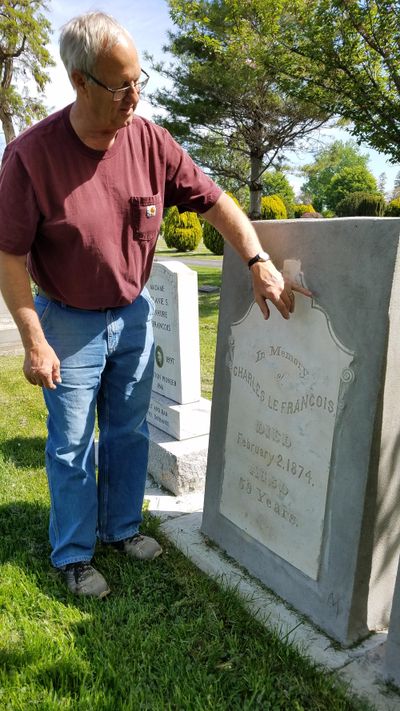Former mason restores historic Idaho headstones

LEWISTON, Idaho – When Mary Minton needed help restoring the headstones of her favorite characters from local history, Russ Boland provided a rock-solid solution.
“I came up with this form and everything,” Boland said of setting the decaying stones in a vertical concrete slab to preserve them indefinitely. “They were so thin and busted, there was no way to get them to stand if you put them back up.”
Boland, who retired a couple of years ago after 26 years as the city of Lewiston’s mason, used his expertise and innovation to help Minton complete the project she’d been working on for five years, the Lewiston Tribune reported.
Minton portrays Lewiston pioneer Melanie S. Bonhore LeFrancois for tour groups who visit various city historical sites. Bonhore LeFrancois built and ran the Hotel DeFrance in downtown Lewiston’s pioneer days. Her grave was moved to the Normal Hill Cemetery from the area above the Fifth Street bluff when the city established Pioneer Park.
The graves of Paul Bonhore and Charles LeFrancois, her first and second husbands, were also moved. But Bonhore LeFrancois’ grave never got a proper marker, and her husbands’ stones toppled and began to crumble.
Lewiston parks technician Chad Hewett first enlisted Boland in the historic preservation realm about 10 years ago when another family was trying to get some headstones repaired. Those headstones were also too thin and brittle to replace as-is, so Boland got to work developing his new technique.
It worked so well that Hewett saved the concrete form Boland built in case it was ever needed again. So when Minton came to him last year looking for a way to restore the Bonhore and LeFrancois stones, Hewett knew just the person to call.
Boland tried to use his original form, but it was too small. So he built a new one from plywood big enough to accommodate the stones, one at a time. Each monolith needed a recess where the stone would later be grouted in place, so Boland laid each one on a piece of rigid foam insulation and traced its shape.
He carefully cut each piece of foam about a half-inch larger than the actual stones so they would have room to fit. After attaching the foam inside the face of the form, he assembled it on-site and braced it to stand up to the weight of the concrete.
Each pour took 10 bags of concrete, which Boland mixed by hand in a bucket. Once it had set, he disassembled the form and removed the foam, leaving a custom-shaped pocket for the headstone.
Boland also used his concrete saw to cut the jagged bottoms off the stones, giving them a much neater appearance. It was then a simple matter of using the same mastic a tile setter would use to secure the stone in place, then grouting around the edge with a mixture of Portland cement and sand. A final topcoat of grout smoothed with a wet sponge gave the surface a uniform, tidy appearance.
Boland also took future maintenance into account by pouring a “mow strip” around each stone so Lewiston parks workers wouldn’t have to use string trimmers to clip the grass at their bases. Bonhore’s stone was set last spring, and LeFrancois’ in the fall.
Minton is planning a dedication ceremony for 6 p.m. May 22 at the graves, which are in section 51 along 15th Avenue. She even speculated that some spectral visitors may be on hand.
“History and the present are intersecting at that moment, and some of these important pioneers from the past may even grace us with their presence,” she said.
Minton wasn’t just the organizer behind the preservation effort. She also got her elbows dirty throughout the process, even using a soft toothbrush to carefully clean the soft stones.
Bonhore’s stone required one final touch since it cracked right through his name, partially obliterating it. Minton had contacted Garlinghouse Memorials in Lewiston for help earlier in her quest to restore the stones, but they didn’t have the expertise. Garlinghouse did ultimately get in on the act, however, by recreating the missing parts of the letters with grout that closely matches the color of the original stone.
Garlinghouse also sold Minton a stone for Bonhore LaFrancois’ grave. She selected an older model that had been sitting outside for years so it wouldn’t look too new, Minton said.
While Minton’s fascination with Lewiston’s early history runs deep, Boland said he’s not really interested in the historic preservation aspect of the project, just the technical stuff.
“I enjoy it,” he said. “I’ve been doing it for 30 years.”